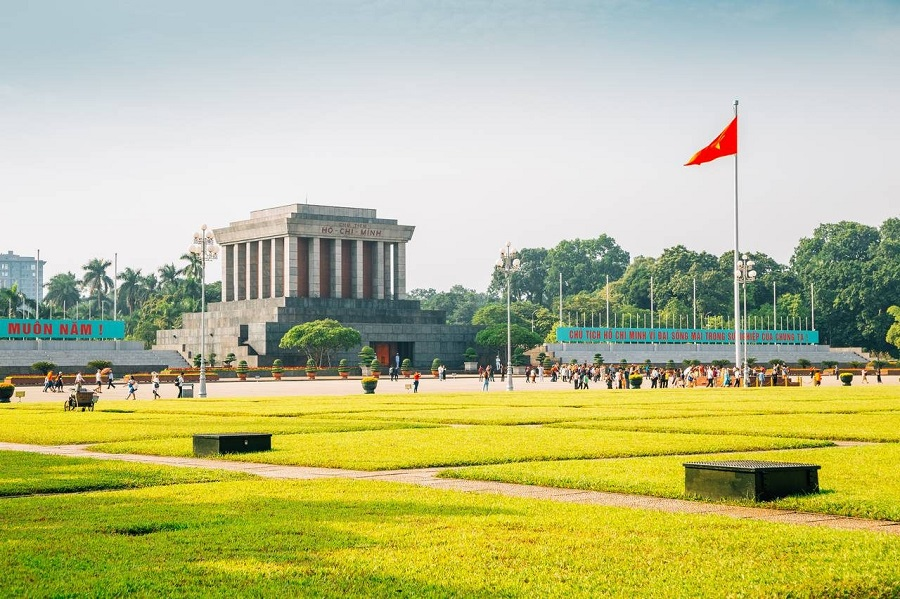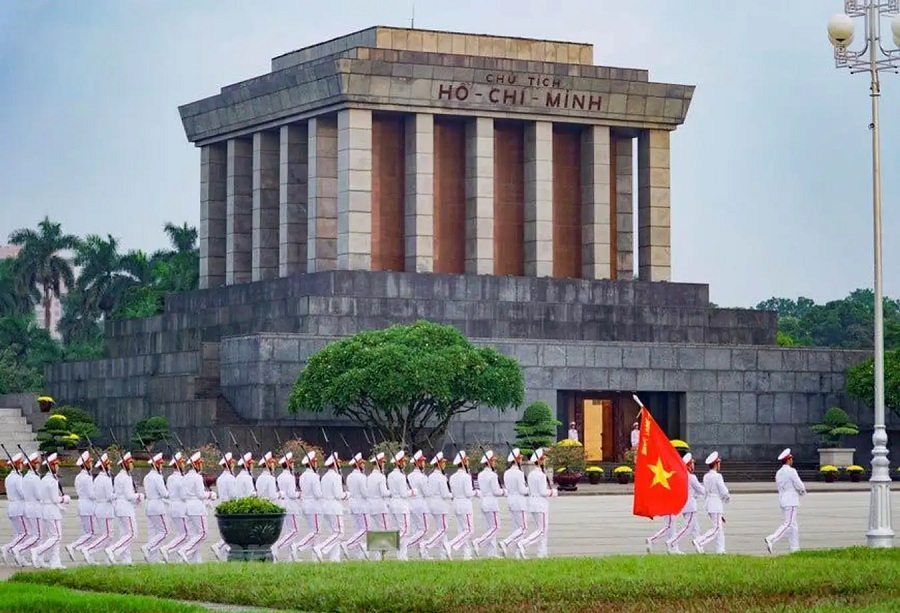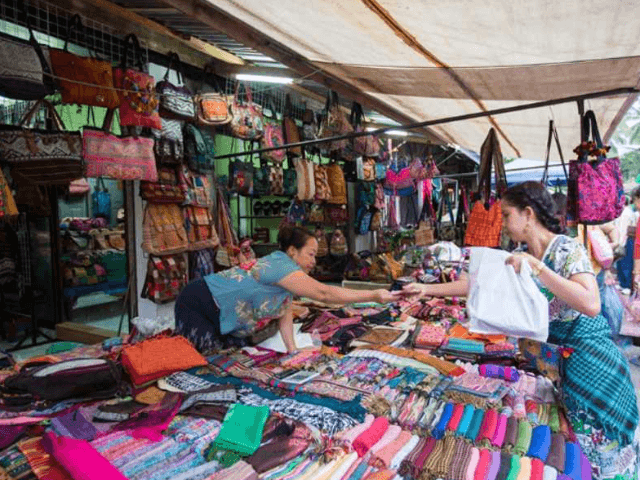Ho Chi Minh Mausoleum is a unique architectural work, showing the affection and respect of the Vietnamese people for the great leader. Let's find out with Threeland Travel now!
TABLE OF CONTENTS
1
1. Explanation of Ho Chi Minh Mausoleum
1.3 “Secret” Ho Chi Minh Mausoleum
1.4 What is special about the architecture of Ho Chi Minh Mausoleum?
1.5 Meaning of Ho Chi Minh Mausoleum relic site
2
2. Notes to know when visiting Ho Chi Minh Mausoleum
2.1 Regulations on visiting Ho Chi Minh Mausoleum
2.2 Ticket price to Ho Chi Minh Mausoleum
2.3 Schedule of visits to Ho Chi Minh Mausoleum
3
3. Visiting prominent places and works around Ho Chi Minh Mausoleum
Ho Chi Minh Mausoleum is a unique architectural work, showing the affection and respect of the Vietnamese people for the great leader. Let's find out with Threeland Travel now!
Located in the middle of Ba Dinh Square, Ho Chi Minh Mausoleum is an attractive destination not to be missed for any visitor when traveling to Hanoi. This place has great significance, is a cultural and historical symbol of Hanoi - the capital of thousands of years of civilization.
1. Explanation of Ho Chi Minh Mausoleum
1.1 Where is Ho Chi Minh Mausoleum? Instructions on how to move
Ho Chi Minh Mausoleum is located at 2 Hung Vuong, Dien Bien Ward, Ba Dinh District, City. Hanoi.
The work was built at a special location - the old platform in the middle of Ba Dinh Square, where President Ho Chi Minh used to chair large rallies and where the reader of the Declaration of Independence gave birth to Socialist Republic of Viet Nam. Therefore, it is not surprising that Ho Chi Minh Mausoleum has become a famous destination and is the top coordinate on the list of places to go out when traveling to Hanoi
There are many means of transportation to Ho Chi Minh Mausoleum. To facilitate your visit, you can refer to some of the following ways:
- Take a private car or rent a motorbike in Hanoi: if you choose this method, save 2 addresses where you can park your car, opposite the Mausoleum Protection Command on Ong Ich Khiem Street or the entrance to the Ho Chi Minh Museum Minh on Ngoc Ha Street.
- Going by taxi: if you don't want to worry about parking problems, renting a taxi in Hanoi is the first choice. Visitors can consider some reputable and famous taxi companies in Hanoi such as Mai Linh, Thanh Cong, and Thang Long.
- By public transport: bus lines 09, 33, 22, 45 and 50 all run through Ba Dinh Square. To make sure you can catch up on bus times, you should look up the schedules of these buses.
- Hanoi City Tour double-decker bus: choosing this form of transportation, visitors will have more interesting experiences when visiting Uncle Ho's Mausoleum in combination with many other famous destinations and admiring the beautiful streets in Hanoi in the safest and most comfortable way.

1.2 The process of building Ho Chi Minh Mausoleum
According to the will of President Ho Chi Minh, he wished that after his death he would be cremated and his ashes would be scattered in three regions of the country. The will of the Party and people at that time was to keep his body intact and put it in the mausoleum so that people across the country could visit and commemorate.
Ho Chi Minh Mausoleum was studied and planned for construction right after the funeral. In January 1970, the Government of the Soviet Union and Vietnam discussed the plan to design, build and equip the mausoleum. Later, the design of the mausoleum was approved by the Politburo of the Party Central Committee with the support of Soviet experts. In February 1973, the project officially started construction.
After 2 years of construction, on August 29, 1975, Uncle Ho's Mausoleum - a sacred and magnificent work in the windy Ba Dinh square was officially completed and he was welcomed back in the joy of the people of the capital and compatriots across the country…

1.3 “Secret” Ho Chi Minh Mausoleum
After half a century, his descendants received touching information. After his death and also during the fierce resistance war against the US, he not only slept in the mausoleum, but he also had 6 historical trips through the city and village to reach secret safe places. Waiting for a day when the country is unified, the people of the South can visit.
In Hanoi, on August 29, 2019, the Presidential Mausoleum Protection Command shared touching information about Uncle Ho's body at the conference summarizing 50 years of long-term preservation and absolute protection of the corpse's safety. The comedy of President Ho Chi Minh (1969 - 2019) was organized by the Management Board of the Presidential Mausoleum.
1.4 What is special about the architecture of Ho Chi Minh Mausoleum?
In front of the mausoleum is Ba Dinh Square with a parade route and 79 lush green trees symbolizing the 79 years of Uncle Ho's life. The overall architecture of the mausoleum is a solid, solid square block, consisting of 3 layers with a height of 21.6m and a width of 41.2m. The mausoleum can withstand bombs, floods and earthquakes with a magnitude of 7 richter.
The outside of the mausoleum is covered with gray granite, granite columns are designed around. On the top of the mausoleum stands out the words PRESIDENT HO CHI MINH made from crimson jade stone. The front hall of the mausoleum is paved with marble highlighting the words "Nothing is more precious than Independence and Freedom" and Uncle Ho's gilded signature. In front of the mausoleum, there are always 2 soldiers guarding, changing shifts every hour.
200 sets of doors in the mausoleum are made by carpentry artisans from rare woods sent by people from all over the country. Inside the Ho Chi Minh Mausoleum is the room where Uncle Ho's body is placed, paved with marble. Here, President Ho Chi Minh's body is placed in a glass cage.
On the copper bed with 3 sides fitted with high-impact glass has a stylized lotus pattern. Thanks to the transparent glass, visitors can see the body of President Ho Chi Minh with faded khaki clothes and simple rubber sandals under his feet in the most clear way. Inside the room, there were always 4 soldiers on duty.

1.5 Meaning of Ho Chi Minh Mausoleum relic site
Ho Chi Minh Mausoleum, a work of great significance that will last forever, a place to express the deep affection and gratitude of the Vietnamese people for the great leader of the nation. Today, this place is not only a cultural and historical symbol of Hanoi but also a destination that attracts millions of visitors.
2. Notes to know when visiting Ho Chi Minh Mausoleum
2.1 Regulations on visiting Ho Chi Minh Mausoleum
When visiting Uncle Ho's Mausoleum, it is necessary to adhere to the following regulations:
- Dress neatly, politely, discreetly and formally
- Go in a straight line according to the instructions of the officer; do not jostle, shove or interrupt the line
- When arriving in front of the mausoleum, visitors should hold their hats and hats in their right hand when coming in front of the mausoleum
- Do not make noise, point or touch the wall, do not put your hands in your pants or shirt pockets, and do not smoke when entering the mausoleum.
- Do not film or take pictures in the room where Uncle Ho's body is located...
2.2 Ticket price to Ho Chi Minh Mausoleum
Vietnamese people and international tourists can visit the Ho Chi Minh Mausoleum for free, without paying any fees.
2.3 Schedule of visits to Ho Chi Minh Mausoleum
The ceremony to visit President Ho Chi Minh is held weekly on Tuesday, Wednesday, Thursday, Saturday and Sunday mornings with the following specific times:
- Summer (April 1 - October 31):
- Weekdays: 07:30 - 10:30
- Saturday, Sunday and public holidays: 7:30 am - 11:00 am
- Winter (November 1 - March 31 next year):
- Weekdays: 08h00 - 11h00
- Saturday, Sunday and public holidays: 08h00-11h30
The organization of the ceremony to visit President Ho Chi Minh is still maintained on May 19, September 2 and the 1st of the Lunar New Year, even if it coincides with Monday or Friday.
3. Visiting prominent places and works around Ho Chi Minh Mausoleum
Besides visiting and admiring the unique architecture of Uncle Ho's Mausoleum, visitors can explore and learn about Uncle Ho's life and the cause of Vietnamese national liberation under his leadership through outstanding places around the mausoleum area such as:
Ba Dinh square
Ba Dinh Square is located right in front of the Ho Chi Minh Mausoleum, which witnessed many sacred moments and important historical events, especially the event that took place on September 2, 1945 - the Declaration of Independence. This work is a proud symbol of the Vietnamese nation.
One Pillar Pagoda
Located in the area of Ho Chi Minh Mausoleum, One Pillar Pagoda has a unique architecture with only one column resembling a thousand-year-old lotus of the capital.

Presidential Palace
The Presidential Palace is a unique building, built in the French classical style. After the French colonialists withdrew from Vietnam, Uncle Ho used this place to work until his death. Currently, this place is only used to welcome officials and organize state events.
House on San, Uncle Ho's fish pond
The house on stilts is the place where Uncle Ho lived until the last years of his life and also the longest residence. This place has witnessed many important and sacred historical events of the country and has become an architectural and cultural heritage with great spiritual values.
Uncle Ho's fish pond located right in front of the stilt house is a precious part of his heritage, where Uncle Ho used to relax and feed the fish.

Ho chi minh museum
If you have visited Uncle Ho's Mausoleum, do not forget to visit the Ho Chi Minh Museum. This is a place to display precious artifacts and documents about the life and people of the great President Ho Chi Minh.
Monument to Heroes and Martyrs
Monument to Heroes and Martyrs is located opposite Ho Chi Minh Mausoleum, next to Thang Long Imperial Citadel, is a place for people to express their gratitude and remember the national heroes who have spared no blood, bones, and courage. feeling of fighting and sacrificing for the cause of the national liberation struggle.
Ho Chi Minh Mausoleum is one of the most famous tourist attractions in Vietnam. Do not miss the opportunity to visit the final resting place of the great leader of the nation, learn more about the history of the country and enjoy the peaceful and dignified atmosphere here. Hope the above information will help you and your loved ones have a Hanoi tour when traveling here.










